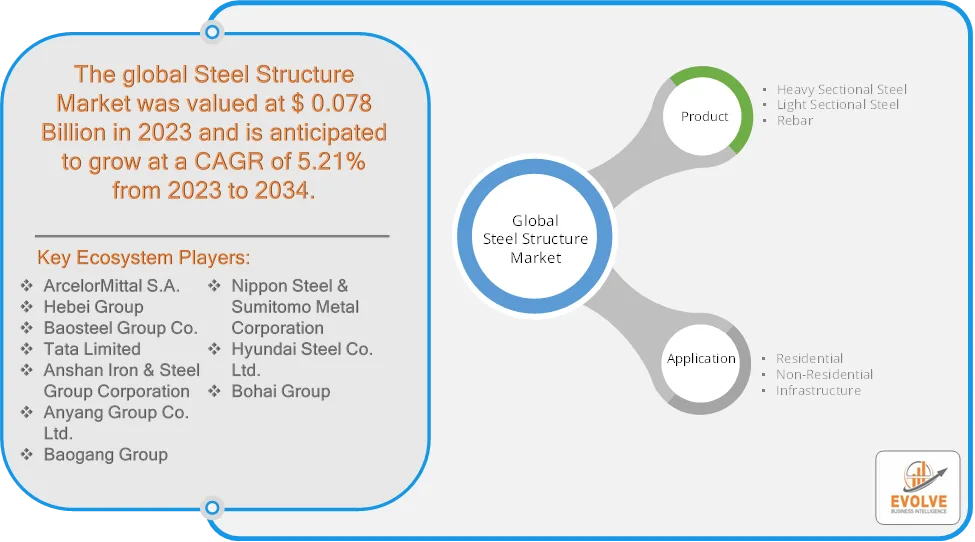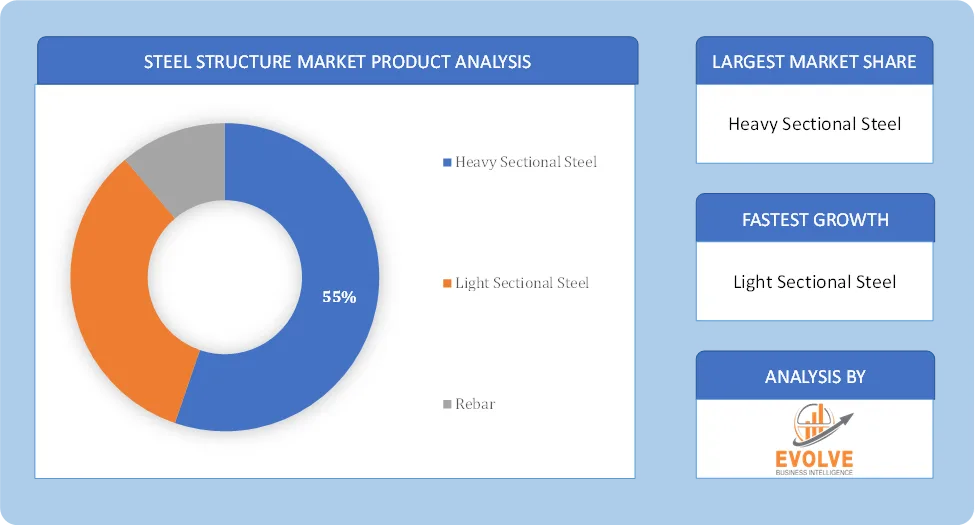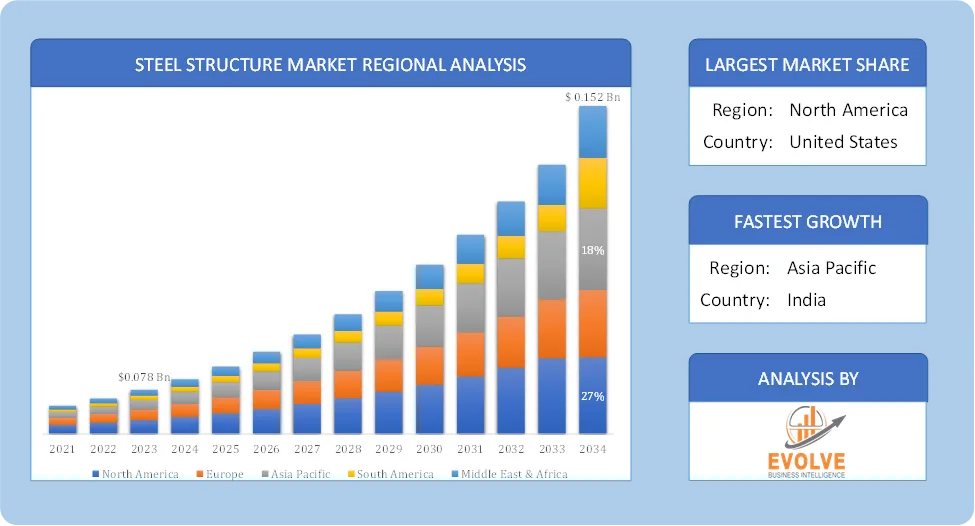Chapter 1. Executive Summary
Chapter 2. Scope Of The Study
2.1. Market Definition
2.2. Scope Of The Study
2.2.1. Objectives of Report
2.2.2. Limitations
2.3. Market Structure
Chapter 3. Evolve BI Methodology
Chapter 4. Market Insights and Trends
4.1. Supply/ Value Chain Analysis
4.1.1. Raw End Users Providers
4.1.2. Manufacturing Process
4.1.3. Distributors/Retailers
4.1.4. End-Use Industry
4.2. Porter’s Five Forces Analysis
4.2.1. Threat Of New Entrants
4.2.2. Bargaining Power Of Buyers
4.2.3. Bargaining Power Of Suppliers
4.2.4. Threat Of Substitutes
4.2.5. Industry Rivalry
4.3. Impact Of COVID-19 on the Steel Structure Market
4.3.1. Impact on Market Size
4.3.2. End-Use Industry Trend, Preferences, and Budget Impact
4.3.3. Regulatory Framework/Government Policies
4.3.4. Key Players' Strategy to Tackle Negative Impact
4.3.5. Opportunity Window
4.4. Technology Overview
12.28. Macro factor
4.6. Micro Factor
4.7. Demand Supply Gap Analysis of the Steel Structure Market
4.8. Import Analysis of the Steel Structure Market
4.9. Export Analysis of the Steel Structure Market
Chapter 5. Market Dynamics
5.1. Introduction
5.2. DROC Analysis
5.2.1. Drivers
5.2.2. Restraints
5.2.3. Opportunities
5.2.4. Challenges
5.3. Patent Analysis
5.4. Industry Roadmap
5.5. Parent/Peer Market Analysis
Chapter 6. Global Steel Structure Market, By Product
6.1. Introduction
6.2. Heavy Sectional Steel
6.3. Light Sectional Steel
6.4. Rebar
Chapter 7. Global Steel Structure Market, By Application
7.1. Introduction
7.2. Residential
7.3. Non-Residential
7.4. Infrastructure
Chapter 8. Global Steel Structure Market, By Region
8.1. Introduction
8.2. North America
8.2.1. Introduction
8.2.2. Driving Factors, Opportunity Analyzed, and Key Trends
8.2.3. Market Size and Forecast, By Country, 2024-2034
8.2.4. Market Size and Forecast, By Product Type, 2024-2034
8.2.5. Market Size and Forecast, By End User, 2024-2034
8.2.6. US
8.2.6.1. Introduction
8.2.6.2. Driving Factors, Opportunity Analyzed, and Key Trends
8.2.6.3. Market Size and Forecast, By Product Type, 2024-2034
8.2.6.4. Market Size and Forecast, By End User, 2024-2034
8.2.7. Canada
8.2.7.1. Introduction
8.2.7.2. Driving Factors, Opportunity Analyzed, and Key Trends
8.2.7.4. Market Size and Forecast, By Product Type, 2024-2034
8.2.7.5. Market Size and Forecast, By End User, 2024-2034
8.3. Europe
8.3.1. Introduction
8.3.2. Driving Factors, Opportunity Analyzed, and Key Trends
8.3.3. Market Size and Forecast, By Country, 2024-2034
8.3.4. Market Size and Forecast, By Product Type, 2024-2034
8.3.5. Market Size and Forecast, By End User, 2024-2034
8.3.6. Germany
8.3.6.1. Introduction
8.3.6.2. Driving Factors, Opportunity Analyzed, and Key Trends
8.3.6.3. Market Size and Forecast, By Product Type, 2024-2034
8.3.6.4. Market Size and Forecast, By End User, 2024-2034
8.3.7. France
8.3.7.1. Introduction
8.3.7.2. Driving Factors, Opportunity Analyzed, and Key Trends
8.3.7.3. Market Size and Forecast, By Product Type, 2024-2034
8.3.7.4. Market Size and Forecast, By End User, 2024-2034
8.3.8. UK
8.3.8.1. Introduction
8.3.8.2. Driving Factors, Opportunity Analyzed, and Key Trends
8.3.8.3. Market Size and Forecast, By Product Type, 2024-2034
8.3.8.4. Market Size and Forecast, By End User, 2024-2034
8.3.9. Italy
8.3.9.1. Introduction
8.3.9.2. Driving Factors, Opportunity Analyzed, and Key Trends
8.3.9.3. Market Size and Forecast, By Product Type, 2024-2034
8.3.9.4. Market Size and Forecast, By End User, 2024-2034
8.3.11. Rest Of Europe
8.3.11.1. Introduction
8.3.11.2. Driving Factors, Opportunity Analyzed, and Key Trends
8.3.11.3. Market Size and Forecast, By Product Type, 2024-2034
8.3.11.4. Market Size and Forecast, By End User, 2024-2034
8.4. Asia-Pacific
8.4.1. Introduction
8.4.2. Driving Factors, Opportunity Analyzed, and Key Trends
8.4.3. Market Size and Forecast, By Country, 2024-2034
8.4.4. Market Size and Forecast, By Product Type, 2024-2034
8.12.28. Market Size and Forecast, By End User, 2024-2034
8.4.6. China
8.4.6.1. Introduction
8.4.6.2. Driving Factors, Opportunity Analyzed, and Key Trends
8.4.6.3. Market Size and Forecast, By Product Type, 2024-2034
8.4.6.4. Market Size and Forecast, By End User, 2024-2034
8.4.7. India
8.4.7.1. Introduction
8.4.7.2. Driving Factors, Opportunity Analyzed, and Key Trends
8.4.7.3. Market Size and Forecast, By Product Type, 2024-2034
8.4.7.4. Market Size and Forecast, By End User, 2024-2034
8.4.8. Japan
8.4.8.1. Introduction
8.4.8.2. Driving Factors, Opportunity Analyzed, and Key Trends
8.4.8.3. Market Size and Forecast, By Product Type, 2024-2034
8.4.8.4. Market Size and Forecast, By End User, 2024-2034
8.4.9. South Korea
8.4.9.1. Introduction
8.4.9.2. Driving Factors, Opportunity Analyzed, and Key Trends
8.4.9.3. Market Size and Forecast, By Product Type, 2024-2034
8.4.9.4. Market Size and Forecast, By End User, 2024-2034
8.4.10. Rest Of Asia-Pacific
8.4.10.1. Introduction
8.4.10.2. Driving Factors, Opportunity Analyzed, and Key Trends
8.4.10.3. Market Size and Forecast, By Product Type, 2024-2034
8.4.10.4. Market Size and Forecast, By End User, 2024-2034
8.5. Rest Of The World (RoW)
8.5.1. Introduction
8.5.2. Driving Factors, Opportunity Analyzed, and Key Trends
8.5.3. Market Size and Forecast, By Product Type, 2024-2034
8.5.4. Market Size and Forecast, By End User, 2024-2034
Chapter 9. Company Landscape
9.1. Introduction
9.2. Vendor Share Analysis
9.3. Key Development Analysis
9.4. Competitor Dashboard
Chapter 10. Company Profiles
10.1. ArcelorMittal S.A.
10.1.1. Business Overview
10.1.2. Government & Defense Analysis
10.1.2.1. Government & Defense – Existing/Funding
10.1.3. Product Portfolio
10.1.4. Recent Development and Strategies Adopted
10.1.5. SWOT Analysis
10.2. Hebei Group
10.2.1. Business Overview
10.2.2. Government & Defense Analysis
10.2.2.1. Government & Defense – Existing/Funding
10.2.3. Product Portfolio
10.2.4. Recent Development and Strategies Adopted
10.2.5. SWOT Analysis
10.3. Baosteel Group Co.
10.3.1. Business Overview
10.3.2. Government & Defense Analysis
10.3.2.1. Government & Defense – Existing/Funding
10.3.3. Product Portfolio
10.3.4. Recent Development and Strategies Adopted
10.3.5. SWOT Analysis
10.4. Tata Limited
10.4.1. Business Overview
10.4.2. Government & Defense Analysis
10.4.2.1. Government & Defense – Existing/Funding
10.4.3. Product Portfolio
10.4.4. Recent Development and Strategies Adopted
10.12.28. SWOT Analysis
10.5. Anshan Iron & Steel Group Corporation
10.5.1. Business Overview
10.5.2. Government & Defense Analysis
10.5.2.1. Government & Defense – Existing/Funding
10.5.3. Product Portfolio
10.5.4. Recent Development and Strategies Adopted
10.5.5. SWOT Analysis
10.6. Anyang Group Co. Ltd.
10.6.1. Business Overview
10.6.2. Government & Defense Analysis
10.6.2.1. Government & Defense – Existing/Funding
10.6.3. Product Portfolio
10.6.4. Recent Development and Strategies Adopted
10.6.5. SWOT Analysis
10.7. Baogang Group
10.7.1. Business Overview
10.7.2. Government & Defense Analysis
10.7.2.1. Government & Defense – Existing/Funding
10.7.3. Product Portfolio
10.7.4. Recent Development and Strategies Adopted
10.7.5. SWOT Analysis
10.8 Nippon Steel & Sumitomo Metal Corporation
10.8.1. Business Overview
10.8.2. Government & Defense Analysis
10.8.2.1. Government & Defense – Existing/Funding
10.8.3. Product Portfolio
10.8.4. Recent Development and Strategies Adopted
10.8.5. SWOT Analysis
10.9 Hyundai Steel Co. Ltd.
10.9.1. Business Overview
10.9.2. Government & Defense Analysis
10.9.2.1. Government & Defense – Existing/Funding
10.9.3. Product Portfolio
10.9.4. Recent Development and Strategies Adopted
10.9.5. SWOT Analysis
10.10. Bohai Group.
10.10.1. Business Overview
10.10.2. Government & Defense Analysis
10.9.2.1. Government & Defense – Existing/Funding
10.10.3. Product Portfolio
10.10.4. Recent Development and Strategies Adopted
10.10.5. SWOT Analysis









